Public Data Lab co-founders Liliana Bounegru and Jonathan Gray will be giving a talk at the Center of Excellence in Image Studies (CESI), University of Bucharest on 12th April 2024. Further details in the poster below.

Public Data Lab co-founders Liliana Bounegru and Jonathan Gray will be giving a talk at the Center of Excellence in Image Studies (CESI), University of Bucharest on 12th April 2024. Further details in the poster below.

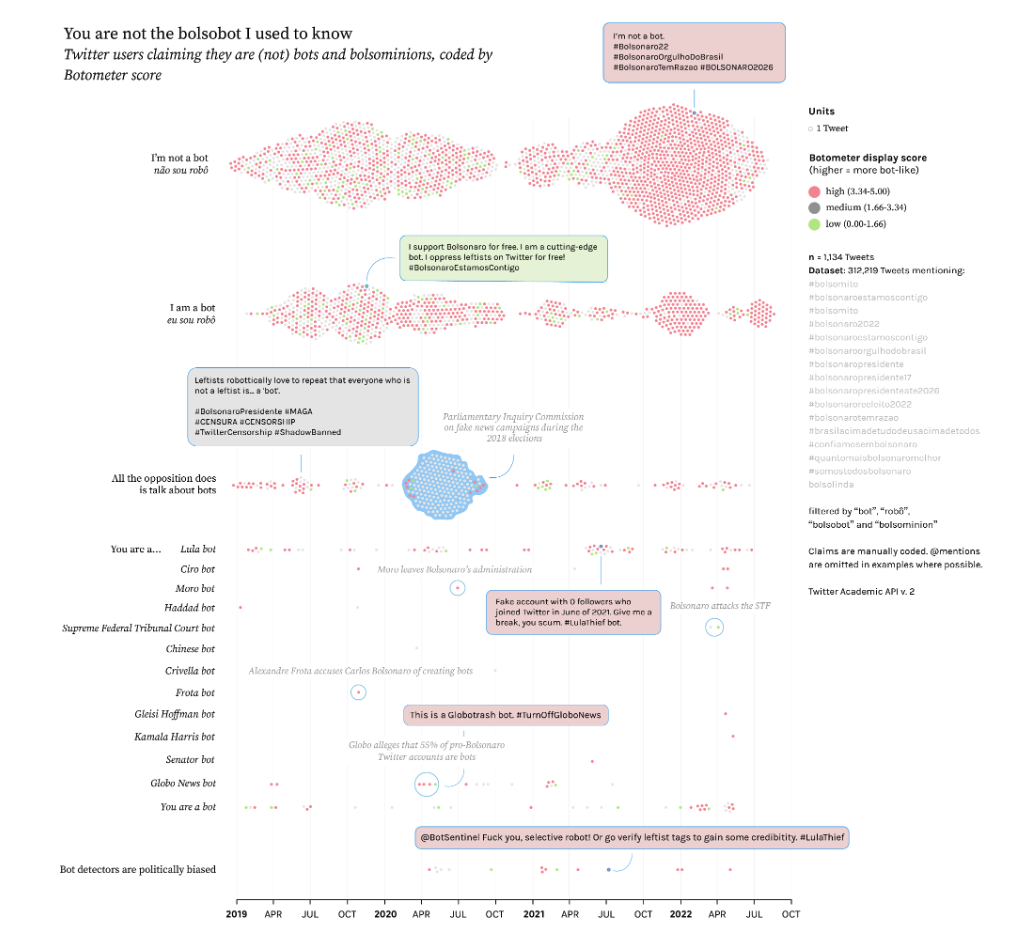
An article on “Quali-quanti visual methods and political bots: A cross-platform study of pro- & anti- bolsobots” has just been published in the special issue “Methods in Visual Politics and Protest” of the Journal of Digital Social Research, co-authored by Public Data Lab associates Janna Joceli Omena, Thais Lobo, Giulia Tucci, Elias Bitencourt, Emillie de Keulenaar, Francisco W. Kerche, Jason Chao, Marius Liedtke, Mengying Li, Maria Luiza Paschoal, and Ilya Lavrov.
The article provides methodological contributions for interpreting bot-associated image collections and textual content across Instagram, TikTok and Twitter/X, building on a series of data sprints conducted as part of the Public Data Lab “Profiling Bolsobot Networks” project.
The full text is available open access here. Further details and links can be found at the project page. Below is the abstract:
Computational social science research on automated social media accounts, colloquially dubbed “bots”, has tended to rely on binary verification methods to detect bot operations on social media. Typically focused on textual data from Twitter (now rebranded as “X”), these methods are prone to finding false positives and failing to understand the subtler ways in which bots operate over time and in particular contexts. This research paper brings methodological contributions to such studies, focusing on what it calls “bolsobots” in Brazilian social media. Named after former Brazilian President Jair Bolsonaro, the bolsobots refer to the extensive and skilful usage of partial or fully automated accounts by marketing teams, hackers, activists or campaign supporters. These accounts leverage organic online political culture to sway public opinion for or against policies, opposition figures, or Bolsonaro himself. Drawing on empirical case studies, this paper implements quali-quanti visual methods to operationalise specific techniques for interpreting bot-associated image collections and textual content across Instagram, TikTok and Twitter/X. To unveil the modus operandi of bolsobots, we map the networks of users they follow (“following networks”), explore the visual-textual content they post, and observe the strategies they deploy to adapt to platform content moderation. Such analyses tackle methodological challenges inherent in bot studies by employing three key strategies: 1) designing context-sensitive queries and curating datasets with platforms’ interfaces and search engines to mitigate the limitations of bot scoring detectors, 2) engaging qualitatively with data visualisations to understand the vernaculars of bots, and 3) adopting a non-binary analysis framework that contextualises bots within their socio-technical environments. By acknowledging the intricate interplay between bots, user and platform cultures, this paper contributes to method innovation on bot studies and emerging quali-quanti visual methods literature.
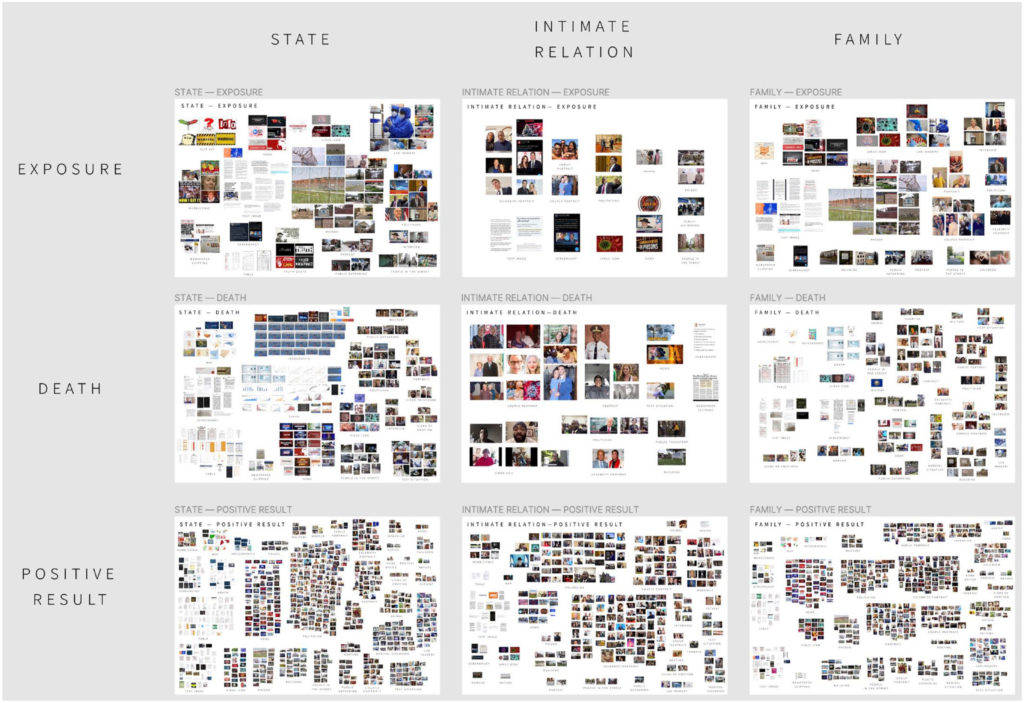
An article on “Testing and Not Testing for Coronavirus on Twitter: Surfacing Testing Situations Across Scales With Interpretative Methods” has just been published in Social Media + Society, co-authored by Noortje Marres, Gabriele Colombo, Liliana Bounegru, Jonathan W. Y. Gray, Carolin Gerlitz and James Tripp, building on a series of workshops in Warwick, Amsterdam, St Gallen and Siegen.
The article explores testing situations – moments in which it is no longer possible to go on in the usual way – across scales during the COVID-19 pandemic through interpretive querying and sub-setting of Twitter data (“data teasing”), together with situational image analysis.
The full text is available open access here. Further details and links can be found at this project page. The abstract and reference are copied below.
How was testing—and not testing—for coronavirus articulated as a testing situation on social media in the Spring of 2020? Our study examines everyday situations of Covid-19 testing by analyzing a large corpus of Twitter data collected during the first 2 months of the pandemic. Adopting a sociological definition of testing situations, as moments in which it is no longer possible to go on in the usual way, we show how social media analysis can be used to surface a range of such situations across scales, from the individual to the societal. Practicing a form of large-scale data exploration we call “interpretative querying” within the framework of situational analysis, we delineated two types of coronavirus testing situations: those involving locations of testing and those involving relations. Using lexicon analysis and composite image analysis, we then determined what composes the two types of testing situations on Twitter during the relevant period. Our analysis shows that contrary to the focus on individual responsibility in UK government discourse on Covid-19 testing, English-language Twitter reporting on coronavirus testing at the time thematized collective relations. By a variety of means, including in-memoriam portraits and infographics, this discourse rendered explicit challenges to societal relations and arrangements arising from situations of testing and not testing for Covid-19 and highlighted the multifaceted ways in which situations of corona testing amplified asymmetrical distributions of harms and benefits between different social groupings, and between citizens and state, during the first months of the pandemic.
Marres, N., Colombo, G., Bounegru, L., Gray, J. W. Y., Gerlitz, C., & Tripp, J. (2023). Testing and Not Testing for Coronavirus on Twitter: Surfacing Testing Situations Across Scales With Interpretative Methods. Social Media + Society, 9(3). https://doi.org/10.1177/20563051231196538

Following the recent release of Gephi Lite, an open-source web-based visual network exploration tool, we interviewed its developers about the background of the project, what they’ve done and future plans…

What is Gephi Lite?
Gephi Lite can actually be defined in two ways. The first definition follows the name we chose: Gephi Lite is a lighter version of the Gephi desktop software, targeting users who need to work on smaller networks with less complex operations in mind.
The second definition is more focused on the technical context: Gephi Lite is a serverless web application to drive visual network analysis. There are no more requirements than an internet connection and a modern web browser.
Continue reading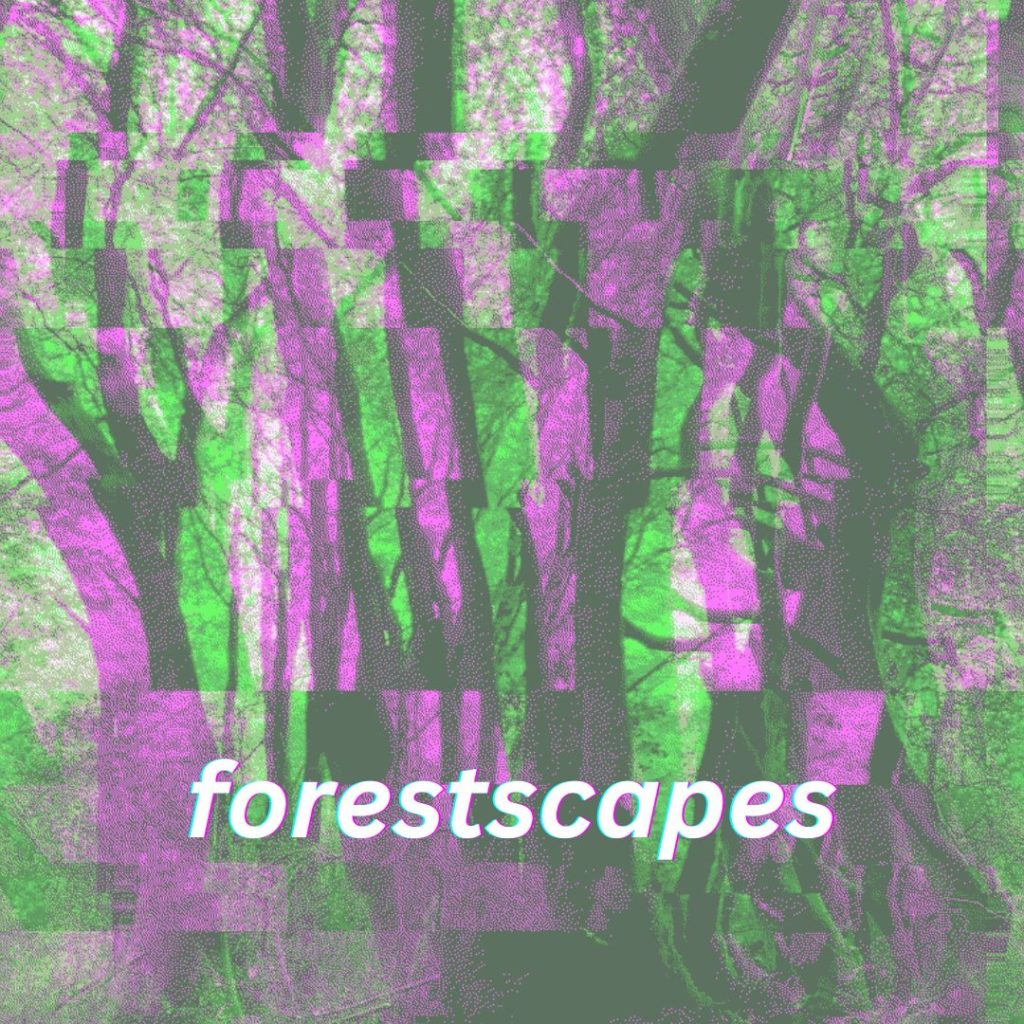
Soundscapes as method
How can soundscapes be used as a way to attend to forest life and the many different ways that we narrate and relate to forests, forest issues and forest protection and restoration efforts?
Forests and their wider ecologies are presented not only as sites of conservation and relaxation, but also as crucial infrastructures in addressing and building resilience against the effects of climate change; habitats for endangered species; hotspots of biodiversity; part of poverty alleviation programmes; sites for ecotourism, health and wellbeing; scenes of neocolonial afforestation; backdrops for corporate greenwashing; landscapes of danger, violence, destruction and resource conflicts; and places where different kinds of planetary futures may emerge. Forests are involved in collective life in many ways.
In this context, the forestscapes project will explore, document and demonstrate generative arts-based methods for recomposing collections of sound materials to support “collective inquiry” into forests as living cultural landscapes. It aims to facilitate interdisciplinary exchanges between natural scientists, social scientists, arts and humanities researchers, artists and public-spirited organisations and institutions working on forest issues.
While many previous works have explored sound as a medium for sensory immersion, (e.g. field recordings), forestscapes explores how recomposing sound material may explore forests as mediatised and contested cultural landscapes: diverse sites of many different (and marginalised) kinds of beings, relations, histories and representations. As part of the project we will co-create new sound works, as well as generative composition techniques using open source software and hardware.
Research on visual methods has explored how to work with “folders of images”, including formats for the re-arrangement of images for collective interpretation. Forestscapes will explore generative methods and techniques for working with “folders of sound” – whether folders of site-based recordings or collections of sounds associated with a particular place gathered from the web and social media.
Further details and materials from the project will be added here.
Call for folders of forest sounds
As part of the project we have an open call for folders of forest sounds. If you have a collection of forest sounds related to a particular site and you’d be interested in exploring soundscaping techniques, we’d love to hear from you.
What? We welcome sounds collected in different contexts, i.e. research projects involving forests in some ways (e.g. ecological restoration, study of climate change impacts, fieldwork, etc); sounds recorded during walks and trips; as well as material collected online.
How? You can tell us about your folders of forest sounds here.
Who? We’re keen to hear from everyone with collections of forest sounds – whether you’re a forest scientist with bioacoustic recordings; an environmental organisation exploring sound as a medium of community engagement; a new media researcher gathering online materials; an ethnographer working with sound materials; a musician working with field recordings from a particular forest site; an artist interested in generative compositional techniques with ecological sounds; or a walker who has gathered a collection of sounds from a forest you often go to.
When? Please submit your files by 17th March 2023.
The forestscapes project is a collaboration between the Department of Geography, the Department of Digital Humanities, the Centre for Digital Culture, the Centre for Attention Studies, the Digital Futures Institute and the Environmental Humanities Network at King’s College London, together with the Public Data Lab. It is supported by the National Environmental Research Council.
The TANTLab is hosting a virtual panel on Jan 25 (5.30 CET) where Public Data Lab members Tommaso Venturini and David Moats will participate together with Laura Nelson from University of British Columbia. The theme of the panel is whether the influx of computational methods challenges ingrained epistemic binaries in SSH. We define an epistemic binary as a dichotomy that (perhaps artificially) separates knowledge production into different kinds.
The panel is arranged as part of the process of editing the forthcoming ‘handbook of digital and computational SSH’ (edited by Public Data Lab members Anders Koed Madsen & Anders Kristian Munk on Edward Elgar). Each of the three authors discuss such binaries in their chapters and this panel brings them together to reflect more broardly on the fate of binaries in contemporary digital knowledge production.
You can read more here and join here.
The following is a cross-post from Rina Tsubaki at the European Forest Institute, drawing on digital methods recipes and approaches developed with the Public Data Lab as part a broader collaboration around the SUPERB project on upscaling forest restoration.
Elon Musk’s takeover of Twitter has prompted confusion among its users and concerns about the platform’s future. Musk’s tweets are gathering daily attention due to large-scale layoffs and safety concerns around the new paid blue verification mark. To make things worse, as its engineers are on their way out of the door, users are also experiencing various technical glitches on the platform. Millions of users – including journalists, researchers and organisations – are already signing up on alternative platforms to be prepared for the platform’s deterioration and demise.
While no one can predict Twitter’s future, it remains widely used by politicians, scientists, companies, NGOs and influencers who are still busy posting on the platform. This includes COP27 in Egypt, where Twitter was one of the main platforms to report on the event. #cop27 has been tweeted over 2.85 million times since 5 November 2022.
Social media platforms can give us additional insights into how broader publics make connections between forest restoration and other social, economic and environmental issues. To see which issues and narratives around forest restoration have been brought up on Twitter in the lead-up to the event, we’ve carried out a series of small explorations based on the digital methods recipes developed by our colleagues at the Department of Digital Humanities, King’s College London and the Public Data Lab who are part of the SUPERB consortium led by EFI. This has been a good way to see if EFI could use these methods independently to understand international events as they unfold.
We usually see a spike in hashtag usage a few days before global events like the COPs. Using #cop27, we collected 217,189 tweets between 5 and 7 November 2022. We then examined the top 1000 hashtags to see which kinds of forest-related issues are present.
Continue reading
Applications are now open for the Digital Methods Winter School and Data Sprint 2023 which is on the theme of “What actually happened? The use and misuse of Open Source Intelligence (OSINT)”.
This will take place on 9-13th January 2023 at the University of Amsterdam. Applications are accepted until 1st December 2022.
More details and registration links are available here and an excerpt on this year’s theme and the format is copied below:
The Digital Methods Initiative (DMI), Amsterdam, is holding its annual Winter School on the ‘Use and Misuse of Open Source Intelligence (OSINT)’. The format is that of a (social media and web) data sprint, with tutorials as well as hands-on work for telling stories with data. There is also a programme of keynote speakers. It is intended for advanced Master’s students, PhD candidates and motivated scholars who would like to work on (and complete) a digital methods project in an intensive workshop setting. For a preview of what the event is like, you can view short video clips from previous editions of the School.
Continue reading

A new article on “Engaged research-led teaching: composing collective inquiry with digital methods and data” co-authored by Jonathan Gray, Liliana Bounegru, Richard Rogers, Tommaso Venturini, Donato Ricci, Axel Meunier, Michele Mauri, Sabine Niederer, Natalia Sánchez-Querubín, Marc Tuters, Lucy Kimbell and Anders Kristian Munk has just been published in Digital Culture & Education.
The article is available here, and the abstract is as follows:
This article examines the organisation of collaborative digital methods and data projects in the context of engaged research-led teaching in the humanities. Drawing on interviews, field notes, projects and practices from across eight research groups associated with the Public Data Lab (publicdatalab.org), it provides considerations for those interested in undertaking such projects, organised around four areas: composing (1) problems and questions; (2) collectives of inquiry; (3) learning devices and infrastructures; and (4) vernacular, boundary and experimental outputs. Informed by constructivist approaches to learning and pragmatist approaches to collective inquiry, these considerations aim to support teaching and learning through digital projects which surface and reflect on the questions, problems, formats, data, methods, materials and means through which they are produced.
Mathieu Jacomy and Anders Munk, TANT Lab & Public Data Lab
6 minutes read
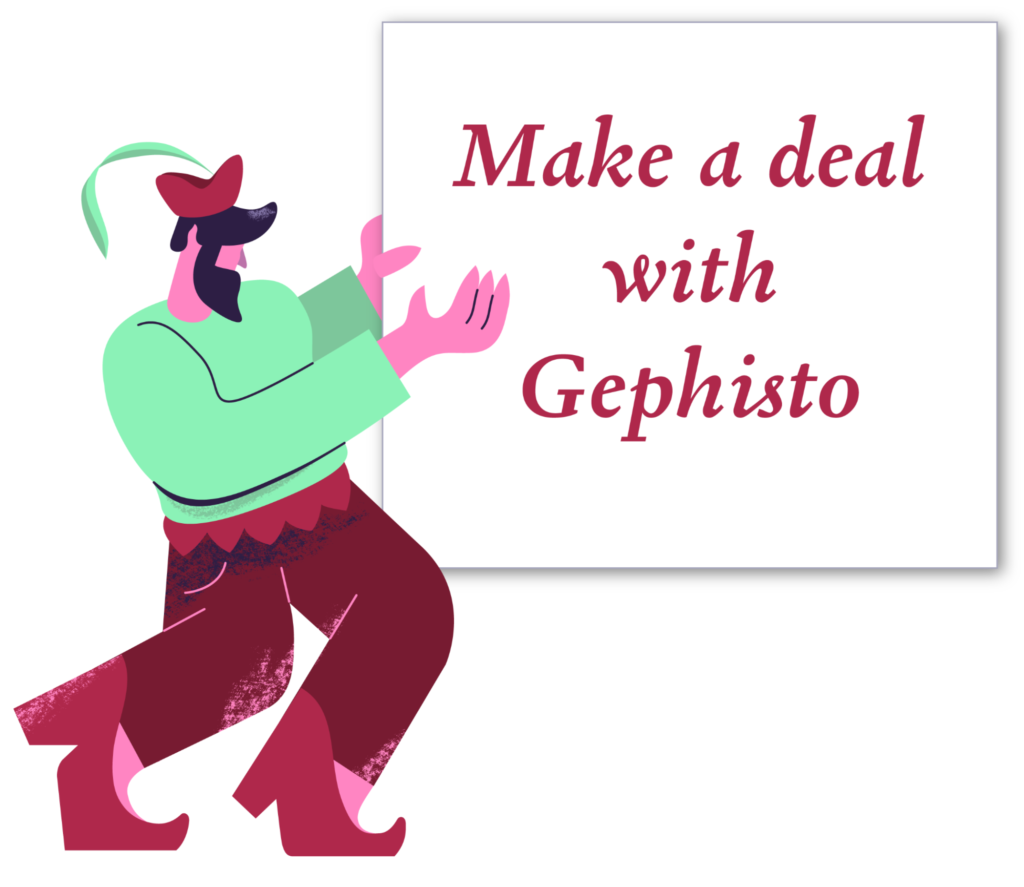
Gephisto is Gephi in one click. You give it network data, and it gives you a visualization. No settings. No skills needed. The dream! With a twist.
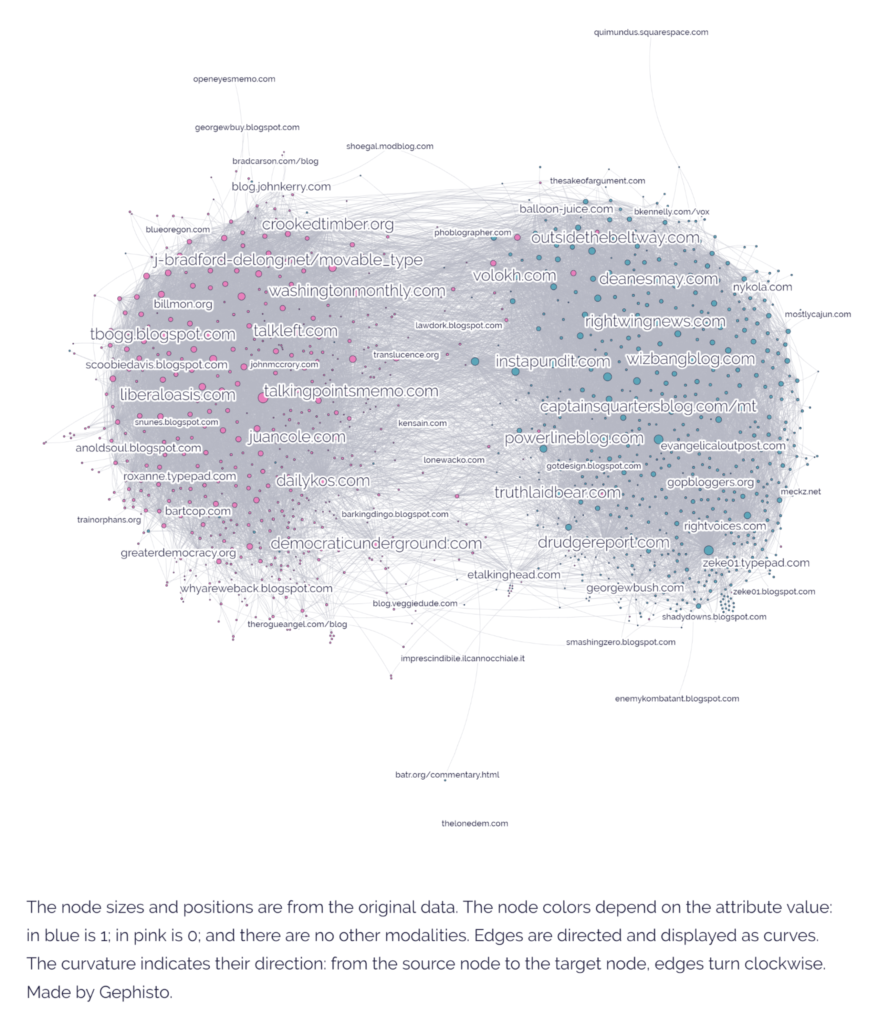
Gephisto produces visualizations such as the one above. It exists as a website, and you can just try it below. It includes test networks, you don’t even need one. Do it! Try it, and come back here. Then we talk about it.
https://jacomyma.github.io/gephisto/
Continue reading